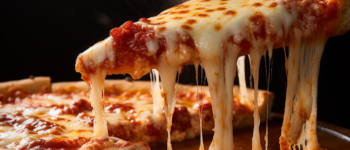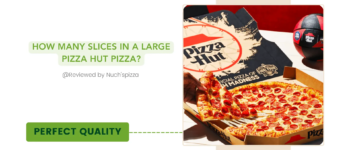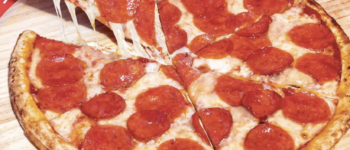It’s no secret that pizza is one of America’s favorite foods. But do you know how many calories in a slice of pizza, exactly? And what other nutritional information is included in a typical pizza serving?
- Minimum Hot Holding Temperature For Pizza – Pizza Bien
- Home Canned Pizza Sauce (from frozen or fresh tomatoes)
- How Big Is An 18-Inch Pizza? – 5 Tips To Get A Delicious Treat
- 12 inch Pizza How Many Slices? How Many People It Feeds?
- How Many Calories Are in a Slice of Pizza? Unveiling the Delicious Truth!
Most people don’t, but it’s a good question to ask – especially if you’re trying to stick to a healthy diet. And this question can be difficult to answer, as there are so many variations of pizza.
However, by examining the nutritional information for some popular types of pizza, we can get an idea of how many calories are in a slice of pizza.
In this blog post, we’ll break down the different types of pizza and give you an idea of how many calories in a slice of pizza. We’ll also give some tips on how to make healthier choices when indulging in your favorite pizza pie.
So whether you’re looking to indulge or stay on track with your diet, read on for more information about the calorie content in pizza. You can make informed decisions about what to eat. Stay tuned!
How Many Calories Are In a Slice Of Pizza?
The calorie content in a slice of pizza can vary greatly depending on the type of crust, toppings, and size of the slice. On average, a typical single slice of cheese pizza, which is usually made with a 14-inch regular crust and basic ingredients such as mozzarella cheese, tomato sauce, and oregano, contains about 285 calories.
However, if you add toppings like pepperoni, sausages, or extra cheese your calorie count will increase. For example, a slice of veggie pizza may contain fewer calories than one with meat toppings. Additionally, a thick-crust pizza will generally have more calories than a thin-crust pizza.
Note: It’s important to keep in mind that these numbers are only estimates and can vary depending on the type of pizza you’re eating and its size.
So, when trying to figure out how many calories are in a slice of pizza, it’s best to refer to the nutritional information provided by the restaurant or pizzeria which you’re ordering from.
This will give you an accurate idea of the calorie content in each slice. In this way, you can make informed decisions about how much pizza you can eat without overindulging.
Tips: Keep in mind, that if you’re going to splurge and indulge in pizza, it’s best to portion out your slices ahead of time so you can better monitor how much you consume. A few extra bites here and there can add up quickly.
Calories In a Pizza Slice By Toppings
When it comes to the calorie content of pizza, the toppings play a large role. The topping you choose will have a major impact on how many calories are in the slice.
Different topping combinations result in varying calorie counts – so this is something to consider when eating pizza. Let’s take a look at 20 of the most popular types of toppings and what they add to your caloric intake:
ToppingsCaloriesProtein (grams)Carbs (grams)Fat (grams)Pepperoni5030.54Mushrooms15220.3Sausage85407Onions340.780.06Bacon4330.13.5Extra cheese7841.55.5Peppers200.740.2Black olives250.21.52Chicken801501Pineapple140.13.50Spinach70.91.10.1Fresh Basil00.10.10Ham1520.10.6Pesto460.70.34.6Beef50503Anchovies13200.5Eggplant50.210Broccoli151.230.2Artichokes50.310Salami352.30.22.7
So, as you can see, the more toppings you add, the higher your calorie count will be. In addition to these above numbers, remember that most pizzerias will offer a variety of crusts and sizes. If you opt for a thicker, garlic-infused crust, your calorie count could increase significantly.
Knowing the calorie and nutritional information of your favorite pizza toppings is a great way to help you make healthier choices when it comes to pizza. You can enjoy a delicious slice of pizza while still staying on track with your diet plan.
Calories In a Pizza Slice By Brand
One of the biggest factors in determining how many calories are in a slice of pizza is the brand. Different brands use special ingredients and different cooking techniques, making each one unique.
Depending on which brand you choose, the calorie contents between pizza brands and styles can vary drastically – some as low as 200 calories in a slice, and some as high as over 600 calories!
To give you a better idea of what to look out for when ordering pizza, here are the calorie counts for a slice of some popular pizza brands:
Calories In a Pizza Hut Pizza Slice
Pizza Hut is one of the most popular pizza chains in America, and many people turn to them for a quick and delicious pizza fix. On average, a slice of Pizza Hut 14-inch cheese pizza (105g), the hand-tossed crust has 289 calories.
This slice contains 11 grams of fat, 19 milligrams of cholesterol, 35 grams of carbohydrates, and 13 grams of protein (This is based on the nutritional information provided by Pizza Hut).
This is the most basic type of pizza you can find at this chain, and it’s usually used as the standard for comparison when looking into the nutritional content of other types of pizzas.
In addition to providing the nutritional content for each type of pizza slice, Pizza Hut also provides detailed information about the ingredients used in their pizzas, as well as allergen warnings. This allows you to further customize your pizza order to meet your dietary needs and preferences.
Note: Keep in mind that nutrition information may vary slightly depending on the location and type of pizza ordered, so always check ingredient lists and allergen warnings to ensure you’re making the best choice.
Calories In a Domino’s Pizza Slice
Classic hand-tossed pizzas at Domino’s Pizza are made with fresh, quality ingredients and feature a variety of tasty toppings. The nutrition information at Domino’s Pizza shows that a slice of 14-inch cheese pizza (108g), classic hand-tossed crust contains 277 calories.
It also has 4.4g of saturated fat, 36g of carbs, and 12g of protein. This number can increase if added toppings, such as pepperoni or sausage. To reduce calorie intake, consider ordering thin-crust pizza or select one of many options for lighter choices such as salads or sides.
Calories In a Papa John’s Pizza Slice
Papa John’s has a delicious range of pizzas that you can choose from. Each pizza slice provides an enjoyable experience for your taste buds. Generally, one slice of Papa John’s 14-inch cheese pizza (117g), the original crust contains 304 calories.
It also includes 11 grams of fat, 38 grams of carbohydrates, and 13 grams of protein. That’s just 15 percent of your daily recommended caloric intake when following a 2,000-calorie diet.
If you’re looking for something with a little more kick, try Papa John’s the works pizza, original crust with 367 calories per slice! Papa John’s pizzas are made with fresh ingredients and dough is made in-house daily.
Calories In a Digiorno’s Pizza Slice
Digiorno has become a household name as the leading brand in the frozen pizza market. Serving up delicious, Italian-style pizza in minutes, DiGiorno has become a household favorite for people looking for an easy weeknight dinner option.
The calories in a single slice (1/4 of pie) of Digiorno’s pizza (161g) with cheese topping, and thin crispy crust are 397. This slice has 16g of fat, 43g of carbohydrates, 34 mg of cholesterol, and 21g of protein.
There are also other varieties of DiGiorno pizza, and their calorie count varies slightly from slice to slice. For example, one slice (1/4 of pie) of Digiorno’s pepperoni pizza (207g), with a rising crust contains 549 calories.
Note: It’s important that all DiGiorno pizzas are made from quality ingredients to ensure the best taste and nutrition in every bite.
The crusts are topped with a blend of cheeses that contain calcium, protein, and other essential vitamins. DiGiorno’s sauces also feature tomatoes and vegetables for added flavor and nutrition.
Calories In a Costo’s Pizza Slice
Costco’s pizza is known for its large size and generous slices with its signature pepperoni and cheese pizza. Costco’s pizza slices contain a significant amount of calories.
On average, one slice of Costco’s cheese pizza (278g) contains 700 calories. This is derived from the combination of 28 grams of fat, 70 grams of carbohydrates, and 44 grams of protein.
While it might seem like a lot of calories for just one slice, remember that each portion is large enough to make two or even three servings depending on your appetite.
In addition to its nutritional value, Costco’s pizza is also made with quality ingredients, including Mozzarella cheese and Pepperoni toppings.
Calories In a Little Caesars Pizza Slice
Little Caesar’s pizza is a great option for those looking for delicious and affordable food. They offer a variety of delicious pizzas, ranging from thin crust to deep dish.
Generally speaking, one slice of Little Caesars 14-inch original round cheese pizza (89g), with regular crust contains 236 calories, 8 grams of fat, 3.7 grams of saturated fat, 28 grams of carbohydrates, and 12 grams of protein.
For those looking for a healthier option, one slice of their thin-crust 14-inch cheese pizza (48g) has only 148 calories with 8 grams of fat, 11 grams of carbohydrates, and 8 grams of protein.
All classic pizzas are made with signature dough recipes and topped with a blend of the finest quality Mozzarella and Muenster cheese. Regardless of the desired topping, Little Caesars Pizza offers a variety of pizzas that can fit anyone’s dietary preferences.
Pizza Nutrition Facts
According to the nutrition information of the United States Department of Agriculture (USDA), a slice of 14-inch cheese pizza (107g) with a regular crust from the typical fast food pizza chain includes:
– Calories: 285
– Total fat: 10 grams (4.8 grams of saturated fat and 0.3 grams of trans fat regulation)
– Cholesterol: 18 milligrams
– Sodium: 640 milligrams
– Potassium: 184 milligrams
– Total Carbohydrate: 36 grams (2.5 grams of dietary fiber and 3.8 grams of sugar)
– Protein: 12 grams
Carbs
The Centers for Disease Control and Prevention (CDC) recommends that adults consuming 1,800 calories a day should include 800-900 calories from carbohydrates, which is roughly 200-225 grams daily.
Carbs are the most abundant nutrient in pizza, with one slice of pizza containing about 36 grams of carbs (information above). So if you are on a 1,800 calories diet and you eat 1 slice of pizza, you are consuming about 20% of the daily recommended value for carbohydrates.
Note: Keep in mind that pizza toppings or sauce can add more carbs to your meal.
A person should therefore pay close attention to their carb intake while consuming pizza, as one slice alone can easily exceed the recommended limits. It is advised to pair pizza with a nutrient-rich vegetable or salad in order to help offset some of the carb content.
Moreover, consuming too many carbs puts an individual at risk of developing chronic health conditions, including obesity, high blood pressure, and type 2 diabetes. For this reason, be sure to be mindful of the overall carb content when eating pizza.
It is important to note that when it comes to carbohydrates, not all are created equal. Therefore, you should consider the source of carbohydrates when making food choices.
See more : How Big Is An 18-Inch Pizza? – 5 Tips To Get A Delicious Treat
The USDA recommends consuming more whole-grain carbohydrates such as brown rice, quinoa, oats, and whole-wheat bread and pasta for a healthier diet.
Fats
Fats in pizza are largely from cheese, usually mozzarella and cheddar. These types of cheese are high in saturated fat and salt which can be unhealthy if consumed in large amounts.
Note: Eating too much saturated fat can raise your cholesterol level and increase the risk of heart disease.
Additionally, limit sodium intake as much as possible. Try to opt for lower-sodium varieties when possible, such as those made with reduced-fat cheese or less processed meats. High levels of sodium can increase blood pressure which could lead to health risks in the long term.
According to the American Diabetes Association, no more than 10% of your daily calories should come from saturated fat. Therefore, people who are eating a 1,800 – 2,000 calories diet should keep their consumption of saturated fat below 20 grams per day.
Meanwhile, the majority of your fat intake should come from unsaturated fats, such as omega-3 and omega-6 fatty acids. Foods rich in these types of fatty acids include nuts (such as almonds, hazelnuts, and pecans), olives, corn, fish, eggs, walnuts, tofu, and flax seed.
It is essential to keep a track of total fat intake from all sources including pizza. Eating pizza too often may contribute to weight gain if you are not consuming a balanced diet.
If you are trying to lose weight, you should choose a thinner crust and opt for healthier toppings. You can also consider ordering whole-wheat or grain pizza dough to add more fiber to your meal.
When making homemade pizza, opt for low-fat cheese and top it with vegetables like mushrooms, peppers, onions, and tomatoes. This will reduce the overall fat content as well as provide you with essential vitamins and minerals.
Protein
Protein is essential for a healthy diet as it helps to build and repair tissues, make enzymes and hormones, as well as provide energy. A slice of pizza can be a great source of protein since it contains an average of 12 grams per slice.
Protein makes up around 24% of calories in a slice of pizza, making it an excellent source of protein in addition to other essential nutrients. Eating pizza can be an easy way to increase your daily intake of protein, but it shouldn’t make up the majority of your diet.
However, depending on your height, activity level, sex, and calorie requirements you may need more or less protein each day. Therefore, it is important to take into consideration your individual needs when planning a balanced diet that includes pizza as part of your meal plan.
To ensure proper protein intake, it is recommended to balance pizza with other sources of lean proteins like seafood, poultry, and legumes. Additionally, incorporating foods with high fiber content, such as fruits and vegetables, into your meals will help you meet your daily protein and calorie needs.
Vitamins and Minerals
In terms of vitamins and minerals, a slice of 14-inch cheese pizza above contains:
– Vitamin C: 2% (based on daily values)
– Calcium: 20%
– Iron: 15%
– Vitamin D: 0%
– Vitamin B6: 5%
– Cobalamin: 6%
– Magnesium: 6%
Pizza can be a source of several essential minerals. It’s important to remember that the quality of the ingredients and preparation methods used will also affect the nutritional value of your slice.
Eating pizza in moderation can help you maintain a balanced diet. Therefore, consider making homemade pizza with lower-fat options like grilled vegetables or lean proteins for a healthier option.
Why Does Pizza Have So Many Calories?
Pizza is a calorie-dense food, which means that it has a lot of calories for its volume. This is because pizza contains many ingredients that are high in fat and carbohydrates. The crust, cheese, toppings, and sauces all add to the overall calorie count.
Toppings such as pepperoni, sausage, and extra cheese will add to the calorie count of a pizza. The number of toppings can also affect how many calories are in a slice of pizza. Some restaurants offer specialty pizzas with higher-calorie ingredients such as chicken, shrimp, and pesto.
Sauces are also a factor when it comes to calories in pizza. This is because most pizza sauces are made with high-fat ingredients such as olive oil, butter, or cream. Pizza sauce made with olive oil, garlic, and tomatoes have fewer calories than a creamy alfredo or pesto sauce.
Additionally, the crust is often made with white flour or refined flour that contains additional fat (such as butter or oil) to enhance flavor. The combination of these components makes pizza one of the most calorie-dense foods available.
Risks When Eating Too Much Pizza
Pizza is a delicious and convenient treat, but it can have health implications if you eat it too often. It’s loaded with calories and fat, and people often consume more than just one slice. Eating too much pizza can lead to weight gain and, in some cases, obesity.
Eating too many calories from any food can also contribute to other health problems like type 2 diabetes and heart disease over time. Additionally, if the pizza is high in saturated fat or salt content, it can raise your cholesterol levels and increase your risk of stroke.
Pizza is also high in sodium, which can lead to an increased risk of hypertension. To avoid this, you should limit the amount of pizza you consume or choose low-sodium varieties with fewer processed ingredients. Additionally, opt for a veggie-piled pie instead of one topped with high-fat meats and cheeses.
However, pizza can also be a healthy part of a balanced diet when eaten in moderation – as long as you make informed decisions about what type of toppings you add. With the right ingredients, pizza can provide essential vitamins and minerals for your body.
So it’s important to consider the type of pizza you’re eating as well as how much. When you know how many calories are in a slice of pizza, you can make better decisions when selecting your toppings or choosing an entire pie.
Can Pizza Fit Into a Healthy Diet?
Pizza can easily fit into a healthy diet. The key is to make smart choices when ordering and preparing your favorite pies. It’s all about making the right choices and moderation.
Making healthier choices when it comes to pizza means looking for options with fewer calories, less fat, and more nutritious ingredients like vegetables and lean proteins.
Healthy Pizza Base
Traditional pizza bases can be high in calories and unhealthy due to the white flour used for the base. There are several alternatives available for creating a healthier version of this beloved Italian classic.
It includes whole wheat, gluten-free, oats, buckwheat, flaxseed meal, rye flour, and so on. If you’re looking for an even healthier option, why not try using ground nuts such as almonds, quinoa, or hazelnuts?
To reduce the amount of gluten in your base, substitute half of the regular flour with whole grain flour. Alternatively, if you’re avoiding gluten completely, try using a mix of white and brown rice.
Vegetables are also an excellent alternative for the pizza base. You could also substitute regular dough with finely grated vegetables such as sweet potato, cauliflower, potato, zucchini, butternut squash, or carrot.
You can also try adding some seeds, and nuts to give your pizza base an extra crunch and nutritional boost. Not only is this low-calorie option packed with vitamins and minerals, but it also adds a unique flavor to your pizza.
Healthy Pizza Toppings
Healthy toppings are a great way to add flavor and nutrition to your meal. Consider adding vegetables such as mushrooms, broccoli, olives, bell peppers, onions, artichoke hearts, tomatoes, spinach, kale, arugula, and roasted vegetables as pizza vegetable toppings.
Lean proteins like chicken, ham, salami, turkey, or seafood like salmon can also add protein to the meal. To boost flavor in a healthy way, use low-sodium seasonings like garlic powder and oregano.
Low-fat dairy, such as feta or mozzarella cheese, is another great choice for topping your pizza. If you’re looking to add a bit of crunch, try adding chopped nuts like pine nuts, sunflower seeds, or walnuts.
Finally, top with fresh herbs such as basil, thyme, or oregano for added flavor without a lot of extra fat and calories. And a drizzle of olive oil can help bring out all the flavors in your healthy pizza.
Healthy Pizza Sauces
Healthy pizza sauces are a delicious and nutritious way to enjoy your favorite pizza without compromising on flavor. There are many options for healthy pizza sauces, from traditional tomato-based ones to creamy white sauces made with pureed vegetables. Many of these sauces can be found pre-made in the supermarket or you can make them at home using fresh ingredients.
Tomato-based sauces are the most common type of pizza sauce and can be made with fresh tomatoes or canned tomato products such as crushed tomatoes or tomato paste. Traditional tomato-based sauces are filled with sodium and sugar, but there are some healthier alternatives that you can use instead.
Pesto is a wonderful alternative to traditional pizza sauce because it uses herbs and nuts for flavor rather than a lot of added sugar and salt. Basil, garlic, and pine nuts are the key ingredients in pesto sauce, so it is a great way to get some flavor without overloading it with unhealthy additives.
Another healthy option for pizza sauce is roasted red pepper puree. Roasted peppers provide plenty of sweetness, as well as fiber and vitamins. This sauce can be made by blending together roasted red peppers, olive oil, garlic, oregano, and a pinch of salt. It is easy to make and tastes great on pizza.
If you want something unique for your pizza sauce, why not try hummus? Hummus is a healthy choice because it uses chickpeas as its base instead of tomatoes, and it is naturally low in fat. Adding some garlic, lemon juice, and herbs to the hummus will give your pizza a unique flavor that you won’t find elsewhere.
Tips For Making Healthier Pizza Choices
You don’t have to give up pizza altogether in order to maintain a healthy diet. There are some things you can do to make sure you’re getting healthier choices. Here are some tips:
1. Go for a smaller-size pizza when you can.
2. Choose thin-crust or whole-wheat crusts to cut down on calories and carbohydrates.
3. Opt for a lighter pizza sauce, such as marinara or pesto. These sauces are lower in calories and fat than cream-based sauces.
4. Choose vegetable toppings like mushrooms, bell peppers, tomatoes, onions, and olives to add flavor while cutting back on fat and calories.
5. Top your pizza with antioxidant-rich ingredients like olives, tomatoes, mushrooms, spinach, and garlic.
6. Ask for half the cheese to still get great flavor without all the fat and calories.
7. Cut down on cheese by opting for lighter cheeses like part-skim mozzarella or feta cheese.
8. Use lean meats like chicken or turkey instead of sausage, pepperoni, or bacon.
See more : How Many Pizzas To Buy or Make: The Ultimate Pizza Calculator!
9. Be mindful of portion size and limit yourself to one or two slices.
10. Make your own pizza at home using healthier ingredients such as low-fat cheese and lean meats.
11. Enjoy a salad on the side to add more fiber and nutrients to your meal.
12. Ask for half-portion sizes when ordering from a restaurant, so you can still enjoy your favorite pizzas without overeating.
By making smarter choices when it comes to pizza, you can still enjoy your favorite food without breaking the calorie bank. So next time you’re in the mood for pizza, keep these tips in mind!
Where Can I Get The Healthiest Pizza?
If you’re looking for healthier pizza options, look no further than your local pizzeria. Many restaurants offer lighter versions of traditional pizzas that still taste great.
These restaurants may also have lighter options for sauces. Or if you’re looking for even healthier options, you might want to consider ordering a gluten-free or vegan pizza.
Gluten-free pizzas typically have fewer calories and carbohydrates than other pizzas, while vegan pizzas are naturally lower in fat and cholesterol. You can also opt for a white pizza – this type of pizza doesn’t contain tomato sauce and is usually lower in calories.
Moreover, you can also make your own healthier version of pizza at home. Start with a whole wheat or gluten-free crust, and add healthy toppings like vegetables, lean proteins, and low-fat cheese.
Common Mistakes When Enjoying Pizza
Trying to eat pizza with a healthy lifestyle can be tricky. Here are some common mistakes you should avoid while still enjoying pizza:
1. Eating too much of it – It’s hard to resist the temptation of a pizza, but eating an entire pizza in one sitting is not recommended. This will lead to consuming far more calories than necessary.
2. Not factoring in toppings – As mentioned earlier, there are many variations when it comes to pizzas. Toppings can significantly increase the calorie count. So if you’re trying to stay on track with your diet, it’s important to factor in all toppings when assessing the number of calories in a slice of pizza.
3. Not paying attention to portion sizes – Many people mistakenly think that one large slice of pizza is equivalent to two or three smaller slices. This is not necessarily the case, so it’s important to know your portion sizes in order to get an accurate assessment of how many calories are in a slice of pizza.
4. Not reading nutrition labels – Although this may be tedious at times, it’s important to read labels when selecting foods. Nutrition labels can provide helpful information about the number of calories in a slice of pizza and other important nutritional facts.
5. Not choosing healthier options – There are many ways to make pizza a healthier choice. Choosing whole wheat or thin crusts, selecting lean meats and high-fiber vegetables as toppings, and opting for low-fat cheese can all help reduce the calories in a slice of pizza.
FAQs Of How Many Calories In a Slice Of Pizza
1. How many calories are in a slice of thin-crust cheese pizza?
A typical slice of thin-crust cheese pizza contains 191 calories. That’s about 10% of the recommended daily calorie intake for an average adult.
A single serving is considered to be one slice, and it provides roughly 8.9 grams of protein, 16.7 grams of carbohydrates, and 9.9 grams of fat.
2. How many calories are in a slice of pepperoni pizza?
A slice of pepperoni pizza typically has 298 calories. The exact number varies depending on the size of the slice and the type of crust used, but it’s generally about 298 calories for a single slice.
When it comes to fat content, a slice of pepperoni pizza usually contains 12.1 grams of fat. This includes both saturated and unsaturated fats, though the exact breakdown depends on the pizza toppings.
In terms of protein content, a slice of pepperoni pizza typically contains 13.3 grams of protein. This is an important source of nutrients for any healthy diet.
Finally, in terms of carbohydrates, a single slice of pepperoni pizza contains 34 grams of carbohydrates. This includes both simple and complex carbs, but the exact breakdown depends on the pizza toppings.
3. How many calories are in a slice of veggie pizza?
A typical slice of veggie pizza contains approximately 260 calories. This calorie count is made up of 12 grams of protein, 34 grams of carbohydrates, and 7 grams of fat.
4. How many carbs are in a slice of pizza?
Carbohydrates are an important part of any healthy diet. This is because they provide the body with energy, and also help to regulate blood sugar levels.
Again, this depends on the type and size of pizza you’re having. A typical slice (107g) of 14-inch regular-crust cheese pizza contains 36 grams of carbohydrates (2.5 grams of dietary fiber and 3.8 grams of sugar).
However, it’s important to note that not all carbs are created equal – some types of carbs can be beneficial, while others can be detrimental to your health.
5. How much pizza is too much?
The amount of pizza you eat in one sitting can have a big impact on your daily caloric intake. While a single slice of pizza isn’t likely to cause significant weight gain, regularly eating too much pizza can contribute to an unhealthy lifestyle.
To keep your portions in check, it’s recommended that you aim to eat no more than two slices of pizza per sitting. Eating more than this might lead to consuming too many calories and fat for your body.
If you’re trying to lose weight, reducing the amount of pizza you eat or opting for healthier alternatives can help you stay on track with your goals. Making smart choices when it comes to pizza consumption is key!
6. Can I eat a slice of pizza every day?
Eating a slice of pizza every day is not recommended. Pizza can be high in calories, fat, and carbohydrates. Eating too much pizza can also lead to weight gain over time.
Additionally, pizza often contains processed meats such as pepperoni and sausage which are high in saturated fats and sodium – both of which can increase your risk for certain health conditions.
Instead of eating a slice of pizza every day, it’s best to plan for occasional indulgences as part of a balanced diet. Eating smaller portions of pizza is another way to reduce your calorie intake while still enjoying your favorite food.
7. Can I eat a whole pizza?
Yes, you can eat a whole pizza! However, it’s important to take into consideration the number of calories in an entire pizza. Depending on the size and type of pizza you choose, it could add up to as much as 2,000+ calories.
For most people, eating that many calories at once would be considered over-indulging. Instead, it may be more beneficial to split the pizza with friends and family or save some for later.
That way, you can enjoy your favorite slice without overdoing it on calories. You can also opt for a thinner crust or smaller size pizza to help reduce calories. Making small changes like these can make a big difference in the total calorie count.
8. Which pizza has the highest calories?
The type of pizza with the highest calories varies from one place to another, but typically, deep-dish pizzas tend to have a higher calorie count than thin-crust pizzas. So if you’re looking for a pizza with the highest calories, a deep dish is the way to go.
Why? Deep-dish pizzas generally require more dough and toppings than regular-crust pizzas. This results in a thicker pizza, which can add an extra 50-100 calories per slice.
9. Which pizza has the lowest calories?
A small, thin-crust slice with no additional toppings can have anywhere from 150 to 200 calories.
10. What makes pizza unhealthy?
The main culprits when it comes to pizza’s unhealthy reputation are the high-calorie, high-fat content of cheese, meats, and sauces. Of course, there are plenty of healthier types of pizza out there (we’ll cover a few in this blog post), but the majority of pizzas you find at restaurants or buy from the store are packed with calories and fat.
Additionally, pizza can be high in sodium, which is another factor that contributes to its less-than-healthy reputation. The combination of cheese, meats, sauces, and seasonings can add up to a hefty dose of salt – something you want to monitor if you’re watching your sodium intake.
11. Can I still eat pizza and lose weight?
Yes! You can still enjoy your favorite foods and lose weight if you’re mindful of portion sizes and topping choices. Try to choose thinner crusts, limit the amount of cheese, opt for vegetable toppings instead of processed meats, and get creative with the sauces.
These simple swaps can reduce the calorie count in your pizza slice. Additionally, you can pair your slice of pizza with a healthy side or salad to add some extra nutrients. Doing so will help you feel more full, and the meal is sure to be satisfying.
12. What to do after eating pizza?
Eating a slice or two of pizza shouldn’t be seen as an unhealthy indulgence if you make smart choices. After eating pizza, it’s best to follow up with a few healthy activities. This could include drinking plenty of water, taking a short walk, and avoiding snacking for at least a couple of hours afterward.
Additionally, try to eat other nutrient-rich foods throughout the day. Eating a balanced diet is essential for keeping your body healthy and energized, even after indulging in pizza. By being mindful of what you eat and making conscious choices about your meals, you can ensure that you’re staying on track with your health goals without sacrificing taste or flavor.
13. Is pizza once a week OK?
Pizza can be part of a balanced diet, as long as you make healthy choices when it comes to toppings and portion sizes. If you’re eating pizza once a week or less, it’s probably okay.
However, if you find yourself indulging in pizza more often than that, it may be a good idea to look for healthier alternatives.
Additionally, you should be aware of the calorie content and make sure to balance out your meals with nutritious foods like fruits, vegetables, lean proteins, and whole grains.
14. How many calories are in 2 large slices of pizza?
It depends on the type of pizza and toppings you choose. Generally speaking, two large slices of 14-inch cheese pizza, with regular crust contain 570 calories.
Be mindful when selecting your toppings to keep the calorie count lower. You might also consider getting a thin-crust pizza or one with less cheese to reduce the calorie count.
15. Is frozen pizza healthy?
Frozen pizzas are convenient, but are they healthy? The answer depends on the type of pizza and its toppings. Generally speaking, frozen pizzas can be high in calories, saturated fat, sodium, and added sugars.
However, not all brands are created equal – some offer healthier options made with whole-grain crusts or reduced-fat cheese. Look for pizzas with less than 350 calories and at least three grams of fiber per serving to help make your pizza healthier.
Eating frozen pizza is also important to look out for portion size. Many brands come in large slices, so consider cutting them into smaller pieces to reduce the calorie content. Additionally, you can always add extra vegetables to your pizza to increase its nutritional content.
Conclusion
Understanding how many calories in a slice of pizza can help you make healthier choices if you’re watching your diet. Different types of pizza have different calorie counts, so be sure to check the label before indulging.
Also, by making small changes like opting for thin crusts and high-quality toppings, you can create a healthier pizza meal. Finally, remember to practice moderation when it comes to eating pizza.
So next time you’re wondering how many calories are in a slice of pizza, you’ll have the answers you need to make healthy dietary choices. With this knowledge about pizza nutrition, you can make better decisions about what to eat.
We hope this blog post has helped you understand the calorie content of pizza better. If you have any questions about pizza calories, please don’t hesitate to leave a comment below. We’d be happy to help.
Enjoy your favorite pizza meal and stay healthy!
Bon appetit!
Nigel Gildon editor:Nigel Gildon is the editor of Chef Wayne’s Big Mamou: Chef Wayne’s Big Mamou. He has worked in the publishing industry for many years and has a passion for helping new authors get their work into the hands of readers. 63 Liberty Street * Springfield, MA 01003









